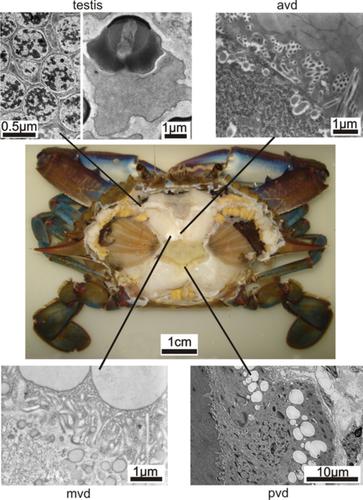当前位置:
X-MOL 学术
›
J. Morphol.
›
论文详情
Our official English website, www.x-mol.net, welcomes your feedback! (Note: you will need to create a separate account there.)
Ultrastructure and histochemistry of the male reproductive system of the genus Callinectes Stimpson, 1860 (Brachyura: Portunidae)
Journal of Morphology ( IF 1.5 ) Pub Date : 2020-10-10 , DOI: 10.1002/jmor.21277 Timoteo T. Watanabe 1, 2 , Fabiana A. Nascimento 1 , Fernando L. Mantelatto 3 , Fernando J. Zara 1, 2
Journal of Morphology ( IF 1.5 ) Pub Date : 2020-10-10 , DOI: 10.1002/jmor.21277 Timoteo T. Watanabe 1, 2 , Fabiana A. Nascimento 1 , Fernando L. Mantelatto 3 , Fernando J. Zara 1, 2
Affiliation

|
We described the ultrastructure and histochemistry of the reproductive system of five Callinectes species, and evaluate the seasonal variation in weight of the reproductive system and hepatopancreas by comparing annual changes of somatic indices. The somatic indices changed little throughout the year. In Callinectes, spermatogenesis occurs inside the lobular testes and, within each lobule, the cells are at the same developmental stage. Spermatogenesis and spermiogenesis follow the same development pattern in all Callinectes studied. Mature spermatozoa are released into the seminiferous ducts through the collecting ducts. Cells of the vas deferens are secretory as evidenced by rough endoplasmic reticulum, Golgi complex, and secretory vesicles that produce the seminal fluid. The anterior vas deferens shows two portions: proximal and distal. In proximal portion (AVDp), spermatozoa are clustered and embedded in an electron‐dense, basophilic glycoproteinaceous secretion Type I. In the distal portion (AVDd), the spermatophore wall is formed by incorporation of a less electron‐dense glycoproteinaceous secretion Type II. The secretion Type I change to an acid polysaccharide‐rich matrix that separates the spermatophores from each other. The median vas deferens (MVD) stores the spermatophores and produces the granular glycoproteinaceous seminal fluid. The posterior vas deferens (PVD) has few spermatophores. Its epithelium has many mitochondria and the PVD seminal fluid changes into a liquid and homogeneous glycoprotein. Many outpocketings in the PVD and MVD help to increase the fluid production. Overall, the reproductive pattern of Callinectes is similar to other species that produce sperm plugs. The secretions of AVD, MVD, and PVD are responsible for the polymerization that forms the solid, waxy plug in the seminal receptacle. The traits identified here are common to all Portunidae species studied so far.
中文翻译:

Callinectes Stimpson 属雄性生殖系统的超微结构和组织化学,1860(Brachyura:Portunidae)
我们描述了 5 种 Callinectes 生殖系统的超微结构和组织化学,并通过比较体细胞指数的年度变化来评估生殖系统和肝胰腺重量的季节性变化。体细胞指数全年变化不大。在 Callinectes 中,精子发生发生在小叶睾丸内,并且在每个小叶内,细胞处于相同的发育阶段。在所研究的所有 Callinectes 中,精子发生和精子发生遵循相同的发育模式。成熟的精子通过收集管释放到生精管中。输精管细胞是分泌性的,如粗面内质网、高尔基复合体和产生精液的分泌囊泡所证明的。前部输精管显示两部分:近端和远端。在近端部分 (AVDp),精子聚集并嵌入电子致密的嗜碱性糖蛋白分泌物 I 型。在远端部分 (AVDd),精子细胞壁是通过掺入电子密度较低的糖蛋白分泌物 II 型形成的。I 型分泌物变为富含酸性多糖的基质,将精囊彼此分开。正中输精管 (MVD) 储存精细胞并产生颗粒状糖蛋白精液。后输精管 (PVD) 的精细胞很少。它的上皮有许多线粒体,PVD精液变成液体和均质的糖蛋白。PVD 和 MVD 中的许多外袋有助于增加流体产量。全面的,Callineectes 的生殖模式与其他产生精子栓的物种相似。AVD、MVD 和 PVD 的分泌物负责聚合,从而在精液容器中形成固体蜡状栓塞。此处确定的特征是迄今为止研究的所有 Portunidae 物种的共同特征。
更新日期:2020-10-10
中文翻译:

Callinectes Stimpson 属雄性生殖系统的超微结构和组织化学,1860(Brachyura:Portunidae)
我们描述了 5 种 Callinectes 生殖系统的超微结构和组织化学,并通过比较体细胞指数的年度变化来评估生殖系统和肝胰腺重量的季节性变化。体细胞指数全年变化不大。在 Callinectes 中,精子发生发生在小叶睾丸内,并且在每个小叶内,细胞处于相同的发育阶段。在所研究的所有 Callinectes 中,精子发生和精子发生遵循相同的发育模式。成熟的精子通过收集管释放到生精管中。输精管细胞是分泌性的,如粗面内质网、高尔基复合体和产生精液的分泌囊泡所证明的。前部输精管显示两部分:近端和远端。在近端部分 (AVDp),精子聚集并嵌入电子致密的嗜碱性糖蛋白分泌物 I 型。在远端部分 (AVDd),精子细胞壁是通过掺入电子密度较低的糖蛋白分泌物 II 型形成的。I 型分泌物变为富含酸性多糖的基质,将精囊彼此分开。正中输精管 (MVD) 储存精细胞并产生颗粒状糖蛋白精液。后输精管 (PVD) 的精细胞很少。它的上皮有许多线粒体,PVD精液变成液体和均质的糖蛋白。PVD 和 MVD 中的许多外袋有助于增加流体产量。全面的,Callineectes 的生殖模式与其他产生精子栓的物种相似。AVD、MVD 和 PVD 的分泌物负责聚合,从而在精液容器中形成固体蜡状栓塞。此处确定的特征是迄今为止研究的所有 Portunidae 物种的共同特征。


























 京公网安备 11010802027423号
京公网安备 11010802027423号